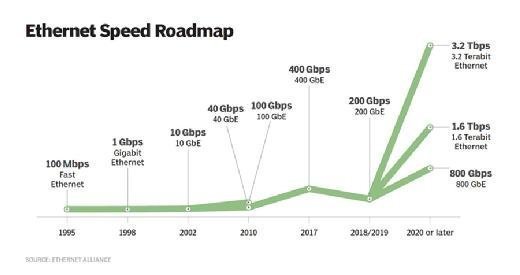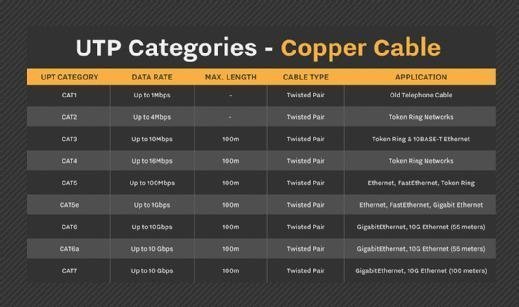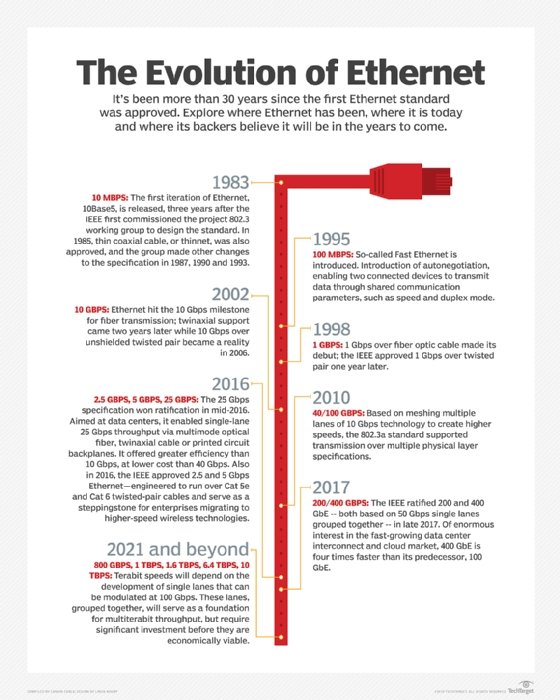What is 1000BASE-T (Gigabit Ethernet)?
1000BASE-T is a Gigabit Ethernet standard that operates at a speed of 1 gigabit per second (Gbps) over copper wiring. One Gb is equivalent to 1,000 megabits per second (Mbps). The standard uses four pairs of Category 5 (Cat5) or higher unshielded twisted pair (UTP) copper cables to achieve the gigabit data rate. The "T" in 1000BASE-T refers to twisted-pair cable. 1000BASE-T can also be referred to as 1000BaseT, GbE, 1 GigE or simply Gigabit.

Understanding 1000BASE-T
1000BASE-T is the most common networking standard in use today. It quickly replaced older Ethernet standards -- such as Ethernet (10BASE-T, 10 Mbps) and Fast Ethernet (100BASE-T, 100 Mbps) -- as the de facto standard for network equipment. Its 1 Gbps speed can be achieved over these types of twisted-wire copper cables: Cat5, Cat5e, Cat6, Cat6e, Cat7 and Cat8.
Established in 1999, the IEEE standard 802.3ab defines 1000BASE-T. 802.3ab defined how Gigabit Ethernet transmission works over UTP Cat5, Cat5e and Cat6 copper cables:
- 1000 sets the transmission speed of 1,000 Mbps, or 1 Gbps.
- BASE sets the standard as Ethernet baseband signaling, meaning it only carries Ethernet signals.
- T sets the cable media type as twisted pair.

Where is 1000BASE-T used?
1000BASE-T is supported by almost all modern equipment, offering good enough performance for most common applications. Almost all networking equipment supports it on the access layer, although some backbone applications require a faster standard. Most home equipment produced in the last decade supports Gigabit Ethernet, enabling home users to enjoy the benefit of high-speed Ethernet in a cost-effective manner.
The Gigabit Ethernet standard can be used in data centers for server interconnects or network switch uplinks or be used directly with the desktop. It is also used for general server interconnects and for endpoint client connections.
Other applications of 1000BASE-T include the following:
- Server-to-server communications.
- Storage networking.
- Network switch uplinks.
- Local area networks.
- Reliable and fast internet for office networks.
- Point-of-sale systems.
- Inventory management systems.
- Electronic health record applications.
- Endpoint client connections.
What are the 1000BASE-T specifications?
1000BASE-T operates at 1 Gbps. It uses cheap and readily available cables that already existed for many applications. It uses four twisted pairs for both half-duplex (nonsimultaneous transmit and receive) and full-duplex communication (simultaneous transmit and receive).
The minimum standard for cabling is Cat5 cable. However, the standard is also readily compatible with all later standards, including Cat5e, Cat6, Cat6e, Cat7 and Cat8.
1000BASE-T maximum cable (segment) length is 100 meters (m), or about 328 feet. It uses the RJ45 connector and jack. RJ45, when properly crimped and attached securely, enables compatibility between 1000BASE-T and existing network infrastructure, which enhances data transmission without requiring major and costly infrastructure overhauls.
Automatic medium-dependent interface crossover is a standard feature for Gigabit Ethernet. This means that Gigabit ports can auto negotiate the transmit between 10 Mbps and 1000 Mbps and receive twisted pairs in the cable. The ports, therefore, do not need crossover cables, and dedicated upload ports on switches are largely redundant. The physical medium attachment sublayer can potentially correct for nonstandard or reversed cabling.
1000BASE-T cabling is also compatible with some faster standards. 2.5GBASE-T (2.5 Gbps) and 5GBASE-T (5 Gbps) Ethernet can use the same Cat5e and Cat6 cables as Gigabit Ethernet. Extremely fast 10GBASE-T (10 Gbps) is capable over Cat6e cables. These standards are interoperable and autonegotiated, enabling simple upgrade paths. This enables businesses and users to continue to use their existing wiring and increase available bandwidth with only relatively minor upgrades.
Gigabit Ethernet operates on Layer 1 of the Open Systems Interconnection model, which is the physical layer. Physical data communication occurs in this layer through physical channels, like copper cables and fiber optic cables.
Advantages and disadvantages of 1000BASE-T
One of the biggest advantages of 1000BASE-T is that it offers high data transfer speeds. However, it consumes more power than its predecessor technologies, which can adversely impact a data center's energy efficiency. Also, as a wired standard, 1000BASE-T relies on copper cabling, offering limited mobility compared to wireless technologies, like Wi-Fi.
Another benefit of Gigabit Ethernet is that existing copper cabling can be used instead of having to rewire with optical fiber or newer-generation cables. It also supports Power over Ethernet, so many devices can receive power and data through a single cable. Thus, this technology provides a cost-effective way to upgrade the existing network infrastructure and support higher bandwidth requirements. For all these reasons, 1000BASE-T is a good Ethernet standard for today's networking and data transmission requirements.
These advantages notwithstanding, Gigabit Ethernet does have some limitations. One major limitation is related to distance. The standard supports a maximum cable length of 100 m. While this length may be sufficient for smaller installations, it may be insufficient for larger or complex installations. Also, extending the cable length can result in signal degradation and errors, which can reduce performance and even lead to loss of connections.
1000BASE-T is backward-compatible with older standards -- 10BASE-T and 100BASE-TX -- so it can be easily integrated with existing network infrastructure. However, some older devices may not be able to negotiate the higher speeds, causing errors or slowdowns.
What are other Gigabit Ethernet standards?
Although the terms 1000BASE-T and Gigabit Ethernet are often used interchangeably, the Gigabit Ethernet standard also includes several other standards. These standards use different types of cables than 1000BASE-T. They can be broadly divided into ones using copper cable and ones using fiber optics.
Copper wire Gigabit Ethernet
- 1000BASE-T uses four pairs of Cat5 or later UTP cable with a maximum allowable cable length of 100 m.
- 1000BASE-TX uses two pairs of shielded twisted pair (STP) using Cat6 or Cat7 cables with a maximum allowable cable length of 100 m. It uses more expensive cables but less expensive electronics. It is no longer widely used.
- 1000BASE-CX uses two pairs of balanced 150 ohm STP cable with a maximum allowable cable length of 25 m. It uses a different connector than 1000BASE-T. It is still used in some specific data center applications.
Fiber optic Gigabit Ethernet
- 1000BASE-SX is a short laser wavelength on multimode fiber optic cable with a maximum allowable cable length of 550 m.
- 1000BASE-LX/LH/LX10 is a long wavelength for a long-haul fiber optic cable with a maximum allowable cable length of 10 kilometers (km).
- 1000BASE-ZX is an extended wavelength single-mode optical fiber for up to 100 km. It is not an IEEE standard, but is supported by many vendors.

Internet and Ethernet both serve to facilitate connectivity and communication, yet they possess distinctions in terms of scope, purpose, reliability and medium. To gain insight into these concepts, refer to this guide on the differences between internet and Ethernet.






